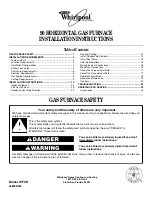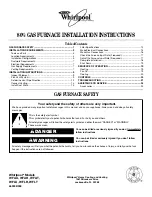
36
Why this concern about allowing the wood to dry?
Green or wet wood is undesirable for several reasons. Green or wet wood tends to mildew and rot which causes
a significant reduction in the thermal value. When green or wet wood is burned, it may take 20 to 25 percent of
the thermal value of the wood heat to evaporate and drive off the moisture which is contained. Green wood
does not burn easily and, in order to keep the fire burning, it is often necessary to add a lot of fuel and provide
excessive draft, thereby decreasing the efficiency of the unit. The excess air needed for combustion must be
heated and it escapes up the chimney wasting heat that should be used to heat the house.
What is creosote?
Wood smoke almost always contains some unburned gases and a fog of unburned tar-like liquids. Some of
these materials will condense on the inside of the chimney, just as steam condenses on any cold surface. This
condensation is a black, tacky, fluid when first formed. When it dries, it is flaky and shiny. Creosote has approximately
the same thermal value as fuel oil. Not only does it reduce the effective size of the chimney, but an accumulation
of this material constitutes a serious fire hazard.
Does green wood cause creosote?
Yes. Indirectly, green wood does cause creosote. The exhaust gases cool as they rise up the chimney. If the
temperature falls below the dew point, any moisture contained in these gases will condense on the inside of the
chimney, absorb the various products of incomplete combustion and form creosote. When green wood is burned,
the exhaust gases carry a high moisture content in addition, because of the heat required for evaporation, these
gases are cooler and more likely to condense than would be the case with dry wood.
Charcoal may be formed more readily if the unit is overcharge particularly, in milder weather. With overcharging
(too much wood in unit) the draft fan will be off a greater percentage of time, coals will be formed which will
become covered with ash in turn will smother the coals to form charcoal. Any coals in the furnace should be
stirred before more wood is added to it. The preceding is an excerpt from a document prepared by the Nova
Scotia Energy Council and the Nova Scotia Research Foundation Corporation.
CREOSOTE AND CHIMNEY FIRES
Wood combustion is never perfectly complete. Wood smoke almost always contains some unburned gases and
a fog of unburned tar-like liquids. Some of these materials will condense out of the flue gases onto any surface
which is not too hot. The condensation is usually dark brown or black, and has an unpleasant acrid odor. It is
called creosote. If condensed on a relatively cool surface (such as an exterior stovepipe chimney), the creosote
will contain a large amount of water along with the organic compounds, and will thus be very fluid. Water is
usually absent if the condensation occurs on surfaces hotter than 1500F. The condensation may then be thick
and sticky, like tacky paint or tar. Creosote may be found almost anywhere in a wood-heating system, from the
top of the chimney to the insides of the cover itself.
Creosote which remains in a chimney after its initial formation may later be significantly modified both in physical
form and chemical content. The water and the more volatile organic compounds tend to evaporate, leaving
the more tar-like substances behind. If these are subsequently heated by the flue gases from a hotter fire (this
usually happens), they themselves are further pyrolyzed to the same final solid product that wood is carbon.
The physical form is usually flaky, and often shiny on one side. Partially pyrolyzed deposits can have a bubbly
appearance. The flakes do not adhere strongly to a stove pipe and thus are easy to brush off; some of the other
forms will not budge even under the action of a stiff wire brush.
The amount of creosote deposited depends mostly on two factors – the density of the smoke and fumes from
the fire, and the temperature of the surface on which it is condensing. Highest smoke densities occur when a
large amount of wood in relatively small pieces is added to a hot bed of coals and the air inlet damper is closed.
Here, there is considerable pyrolysis of wood, but little combustion, and little air to dilute the smoke. In practice,
creosote generation is higher during low-power, overnight, smoldering burns. Smoke densities are least when
combustion is relatively complete, which tends to be the case when the amount of excess air admitted to the
wood-burner is high. Leaky stoves, open stoves and fireplaces typically have the least creosote problems.
One way to lower the average smoke density in an airtight stove is to use less wood each time fuel is added,
and/or to use larger pieces of wood. In either case, the air supply need not be turned down so much in order to
limit the heat output and combustion is likely to be more complete. Of course, if less wood is added, stoking must
be more frequent. A related procedure to limit creosote is to leave the air inlet moderately open after adding
wood until the wood is mostly reduced to charcoal, and then close the inlet as much as desired. This will promote
complete combustion during pyrolysis, when the creosote compounds are being formed, but there will be a
significant heat surge while the gases are burning.
Extra air can also be added to the flue gases in the stove pipe; this is what the Ashley creosote inhibitor does.
But the net effect of adding dilution air is not obvious or necessarily beneficial. Dilution air will decrease the
smoke density, but it will also decrease its temperature. These effects have opposing influences on creosote
Содержание CL 115C
Страница 7: ...7 Figure 7 FLUE PIPE CONNECTION MINIMUM INSTALLATION CLEARANCES...
Страница 17: ...17 Figure 11 TYPICAL A C COIL INSTALLATION...
Страница 18: ...18 Figure 12 WIRING DIAGRAM WITH AIR CONDITIONING...
Страница 19: ...19 Figure 13 CL SERIES WIRING DIAGRAM...
Страница 23: ...23 Figure 17 1E AERO PGB 220 370 GAS BURNER EXPLODED ASSLY...
Страница 25: ...25 Figure 17 1G THERMO DISC MOUNTING ON BURNER PLATE...
Страница 26: ...26 Figure 17 2A AERO BURNER EXPLODED ASSEMBLY...
Страница 28: ...28 Figure 17 3A BECKETT BURNER EXPLODED ASSEMBLY...
Страница 56: ...Figure 17 3A ASSEMBLAGE EXPLOD DU BR LEUR BECKETT...
Страница 58: ...FIG 17 2A BR LEUR AERO ASSEMBLAGE CLAT...
Страница 59: ...FIG 17 1G LE DISQUE DE THERMO MONTE SUR LA PLAQUE DE BR LEUR...
Страница 64: ...FIG 13 C BLAGE DE LA S RIE CL...
Страница 74: ...FIG 7 RACCORDEMENT DU TUYAU DE FUM E ET ESPACE LIBRE MINIMAL FIG 8 EMPLACEMENTS DES COMMANDES...
















































